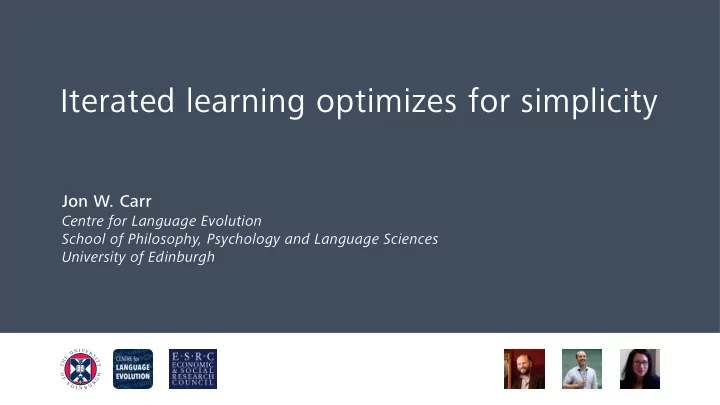

Iterated learning optimizes for simplicity Jon W. Carr Centre for Language Evolution School of Philosophy, Psychology and Language Sciences University of Edinburgh
Pressures shaping language Language
Pressures shaping language e l p m i S Language Learning
Pressures shaping language e l p m i S Language Learning Communication e v i t a m r o f n I
Kinship terms are simple and informative English Northern Paiute 4 3 ⬅ Informative 2 1 0 0 50 100 ⬅ Simple Kemp & Regier (2012)
Lab experiments Learning-only Learning + Communication
Learning and communication pressures 4 tuge tuge tuge tuge tuge tuge Learning-only tuge tuge tuge tupim tupim tupim 3 miniku miniku miniku tupin tupin tupin poi poi poi poi poi poi poi poi poi pihino nemone piga kawake Kirby, Cornish, & Smith (2008) 2 ⬅ Informative kapa gakho wuwele nepi 1 newhomo kamone gaku hokako egewawu egewawa egewuwu ege Learning + Kirby, Tamariz, Cornish, & Smith (2015) Communication-only communication mega megawawa megawuwu wulagi 0 0 50 100 gamenewawu gamenewawa gamenewuwu gamene ⬅ Simple Kirby, Tamariz, Cornish, & Smith (2015)
Iterated learning gives rise to informative spatial terms Carstensen, Xu, Smith, Regier (2015)
Experiment 1
Stimuli Angle Size
Stimuli Angle Size
Stimuli Angle Size
Stimuli Angle Size
Conditions Angle-only Size-only Angle & Size Easy to learn but low informativeness Informative but hard to learn
Training phase
Test phase
Results Angle-only
Results Size-only
Results Angle & Size
Result: Learnability advantage for the less informative systems
Experiment 2
Iterated learning
1 category 2 categories 3 categories 4 categories
Measuring simplicity
Measuring simplicity 1×1 3×3 1×1 3×4 4×8 1×1 1×8 1×2 2×6 4×8 1×4 1×2 2×3 1×6
Simplicity
Simplicity Informativeness
Simplicity Informativeness
Simplicity Informativeness
What makes language informative? Expressivity A system of many categories is more informative Convexity A system of convex categories is more informative than a system of few categories than a system of nonconvex categories Balanced categories A system of equally sized categories is more Discreteness A system of discrete categories is more informative informative than a system of unequally sized categories than a system of fuzzy categories Dimensionality A system that uses many dimensions is less (?) Compactness A system of compact categories is more informative than a system that uses few dimensions informative than a system of noncompact categories
What makes language informative? Learning Communication Pressure for simplicity Pressure for informativeness Expressivity A system of many categories is more informative than a system of few categories Convexity A system of convex categories is more informative than a system of nonconvex categories
What makes language informative? Learning Communication Pressure for simplicity Pressure for informativeness Expressivity A system of many categories is more informative than a system of few categories Convexity A system of convex categories is more informative than a system of nonconvex categories
What makes language informative? Learning Communication Pressure for simplicity Pressure for informativeness Expressivity A system of many categories is more informative than a system of few categories Convexity A system of convex categories is more informative than a system of nonconvex categories
What makes language informative? Learning Communication Pressure for simplicity Pressure for informativeness Expressivity A system of many categories is more informative than a system of few categories Convexity A system of convex categories is more informative than a system of nonconvex categories Our experiments
What makes language informative? Learning Communication Pressure for simplicity Pressure for informativeness Expressivity A system of many categories is more informative than a system of few categories Convexity A system of convex categories is more informative than a system of nonconvex categories Carstensen et al.
Conclusions The pressure from learning yields simple languages, but this can manifest itself through multiple semantic properties: Expressivity Loss of words/categories to aid learning Convexity Reorganization of the meaning space to aid learning The pressure from communication has the same effect on convexity as learning does, making it difficult to identify the causal mechanism. In iterated learning, the pressure for simplicity favours semantic category systems that are convex – informativeness comes along for the ride.
Thanks!
Recommend
More recommend